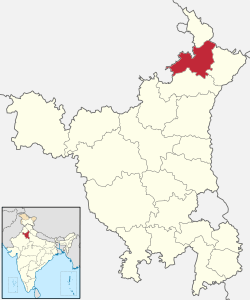Naraingarh
| Naraingarh | |
|---|---|
| city | |
 Naraingarh  Naraingarh Location in Haryana, India | |
| Coordinates: 30°28′35″N 77°07′40″E / 30.47639°N 77.12778°ECoordinates: 30°28′35″N 77°07′40″E / 30.47639°N 77.12778°E | |
| Country |
|
| State | Haryana |
| District | Ambala |
| Population (2011) | |
| • Total | 30,968 |
| Languages | |
| • Official | Hindi |
| Time zone | IST (UTC+5:30) |
| PIN | 134203 |
| Telephone code | 91 1734 |
| Vehicle registration | HR-04 |
| Website |
haryana |
Naraingarh (also: Narayangarh) is a city, municipal committee and assembly constituency in the Ambala district of the Indian state of Haryana. It is approximately 36 km from Ambala Cantt and 55 km from Chandigarh.
Demographics
As per 2011 census of India, Naraingarh has 30,968 of total population (16406 M, 14562 F. 52% of whom are male and 48% are females (approx figures)) [1]
As of the 2001 India census,[2] Naraingarh had a population of 18,209, 53% of whom are male, and 47% female. Naraingarh has an average literacy rate of 73%, compared to the national average of 59.5%. Male literacy is 79%, and female literacy is 68%. In Naraingarh, 12% of the population is under 6 years of age.
History
Naraingarh is the headquarters of one of Ambala's subdistricts.
Naraingarh Fort
The Naraingarh Fort was built and namesake city was founded by the Rajput King of Sirmur State (currently in Himachal Pradesh), Raja Laxmi Narayan.[3] After the decline of the Mughal empire, the King of Sirmur State (built a palace in Kulshan village and renamed it Naraingarh.[3] Subsequently, the sikhs under Maharaja Ranjit Singh defeated the Rajputs in a vicious and decisive battle and established their own kingdom.
Tomb of Shah Zia Ud Din Muhammed

Zia Ud Din Muhammed also known as Qazi Zia-ud-Din was foreign invader in the army of Muhammad Gauri who destroyed temples after defeating Hindu Rajput King Prithvīrāj Chauhān. This tomb has the grave of Muhammad Gauri's general Qazi Zia-ud-Din built at the site of a temple after destroying it.[4] Gauri had appointed Qazi Zia-ud-Din whom the governor of Bhatinda province and Naraingarh used to be under Bhatinda province during those times.
In 1191, Mu'izz proceeded towards Hindustan through the Khyber Pass in modern-day Pakistan and was successful in reaching Punjab. Mu'izz captured a fortress, Bathinda in present-day Punjab state on the northwestern frontier of Prithvīrāj Chauhān's kingdom. After appointing a Qazi Zia-ud-Din as governor of the fortress,[5] he received the news that Prithviraj's army, led by his vassal prince Govind Tai were on their way to besiege the fortress. The two armies eventually met near the town of Tarain, 14 miles from Thanesar in present-day Haryana. The battle was marked by the initial attack of mounted Mamluk archers to which Prithviraj responded by counter-attacking from three sides and thus dominating the battle. Gauri mortally wounded Govind Tai in personal combat and in the process was himself wounded, whereupon his army retreated and Prithvīrāj's army was deemed victorious.[6]
In 1206, Mu'izz, having settled the affairs in India,[7] left all the affairs in India in hands of his slave Qutbu l-Din Aibak.
On his way back to Ghazni, his caravan rested at Dhamiak near Sohawa (which is near the city of Jhelum in the Punjab province of modern-day Pakistan). He was assassinated on March 15, 1206, while offering his evening prayers. The identity of Mu'izz's assassins is disputed, with some claiming that he was assassinated by local Gakhars Hindu Jat and others claiming he was assassinated by Khokhars Hindu Jat or even Ismailis (a claim considered far fetched) .
Hasan Nizami and Ferishta record the killing of Mu'izz at the hands of the local Gakhars who were all Hindu Jat and Hindu Rajput (Ghakar gotra is common across Jats and Rajputs as they come from same ancestor) during those times who were angry at all the destruction of villages and temples. However, Ferishta may have confused the Ghakars with the Khokhars who too were Hindu Jats during those times.
All the historians before the time of Ferishta agree that the Khokhars, not the Gakhars, killed Mu'izz.[8]
Education
There are a number of high Schools in Naraingarh, providing both English and Hindi education. Among these are the Government Senior Secondary School (which has both a boys only and a girls only students) and, VSK International School, Blue Bells Sr. Sec., DAV Public Sr. Sec. and Shivalik International schools (which all provide English education).
The Geeta Senior Secondary School, Aarya Samaj Senior Secondary School provides classes in both Hindi and English.
There are also several colleges in Naraingarh, such as the Government College, the ICL College of Engineering & Technology and the E-max College of Engineering and Technology and SRM College of Engineering and Education.
References
- ↑ "Census of India 2001: Data from the 2001 Census, including cities, villages and towns (Provisional)". Census Commission of India. Archived from the original on 2004-06-16. Retrieved 2008-11-01.
- ↑ "Census of India 2001: Data from the 2001 Census, including cities, villages and towns (Provisional)". Census Commission of India. Archived from the original on 2004-06-16. Retrieved 2008-11-01.
- 1 2 Encyclopaedia of Tourism Resources in India by Manohar Sajnani, Volume 1, page-98
- ↑ Hindu Temples: What Happened to Them - authored by Shourie, Narain; Dubashi, Swarup and Ram Goel
- ↑ Cambridge History (Page 40)
- ↑ A Global Chronology of Conflict: From the Ancient World to the Modern Middle East, Vol. I, ed. Spencer C. Tucker, (ABC-CLIO, 2010), 263.
- ↑ Michel Biran, The Empire of the Qara Khitai in Eurasian History, (Cambridge University Press, 2005), 70.
- ↑ "Mu'izz-al-Din Muhammad ibn Sam (Ghurid ruler of India) – Britannica Online Encyclopedia". Britannica.com. Retrieved 2009-08-09.
